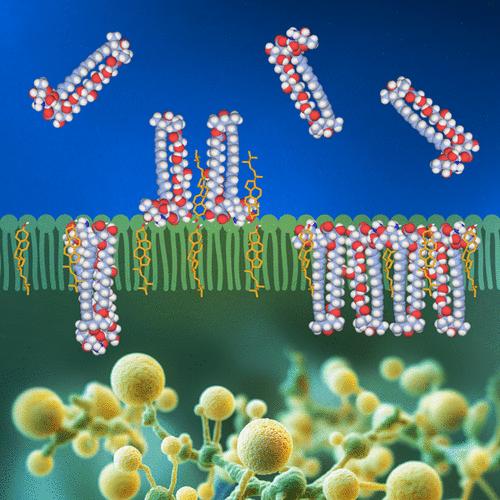当前位置:
X-MOL 学术
›
J. Phys. Chem. Lett.
›
论文详情
Our official English website, www.x-mol.net, welcomes your feedback! (Note: you will need to create a separate account there.)
How Does the Antibiotic Amphotericin B Enter Membranes and What Does It Do There?
The Journal of Physical Chemistry Letters ( IF 5.7 ) Pub Date : 2024-04-26 , DOI: 10.1021/acs.jpclett.4c00496 Sebastian Janik 1 , Rafal Luchowski 1, 2 , Ewa Grela 1, 3 , Wojciech Grudzinski 1 , Wieslaw I. Gruszecki 1
The Journal of Physical Chemistry Letters ( IF 5.7 ) Pub Date : 2024-04-26 , DOI: 10.1021/acs.jpclett.4c00496 Sebastian Janik 1 , Rafal Luchowski 1, 2 , Ewa Grela 1, 3 , Wojciech Grudzinski 1 , Wieslaw I. Gruszecki 1
Affiliation

|
Amphotericin B is a popular antifungal antibiotic, but the exact way it works is still a matter of debate. Here, we used monolayers composed of phosphatidylcholine with ergosterol as a model of fungal lipid membranes to study drug incorporation from the aqueous phase and analyze the molecular reorganization of membranes underlying the biological activity of the antibiotic. The results show that the internalization of antibiotic molecules into membranes occurs only in the presence of ergosterol in the lipid phase. Comparison of images of solid-supported monolayers obtained by atomic force microscopy and lifetime imaging fluorescence microscopy shows the formation of intramembrane clusters of various sizes in the lipid phase, consisting mainly of antibiotic dimers and relatively large membrane pores (∼15 nm in diameter). The results reveal multiple modes of action of amphotericin B, acting simultaneously, each of which adversely affects the structural properties of the lipid membranes and their physiological functionality.
中文翻译:

抗生素两性霉素 B 如何进入细胞膜以及在那里起什么作用?
两性霉素 B 是一种流行的抗真菌抗生素,但其确切的作用方式仍然存在争议。在这里,我们使用由磷脂酰胆碱和麦角甾醇组成的单层作为真菌脂质膜的模型来研究水相中的药物掺入,并分析抗生素生物活性背后的膜分子重组。结果表明,抗生素分子只有在脂相中存在麦角甾醇的情况下才会内化到膜中。通过原子力显微镜和寿命成像荧光显微镜获得的固体支撑单层图像的比较表明,在脂质相中形成了各种尺寸的膜内簇,主要由抗生素二聚体和相对较大的膜孔(直径约15 nm)组成。结果揭示了两性霉素 B 的多种作用模式,同时作用,每种模式都会对脂质膜的结构特性及其生理功能产生不利影响。
更新日期:2024-04-27
中文翻译:

抗生素两性霉素 B 如何进入细胞膜以及在那里起什么作用?
两性霉素 B 是一种流行的抗真菌抗生素,但其确切的作用方式仍然存在争议。在这里,我们使用由磷脂酰胆碱和麦角甾醇组成的单层作为真菌脂质膜的模型来研究水相中的药物掺入,并分析抗生素生物活性背后的膜分子重组。结果表明,抗生素分子只有在脂相中存在麦角甾醇的情况下才会内化到膜中。通过原子力显微镜和寿命成像荧光显微镜获得的固体支撑单层图像的比较表明,在脂质相中形成了各种尺寸的膜内簇,主要由抗生素二聚体和相对较大的膜孔(直径约15 nm)组成。结果揭示了两性霉素 B 的多种作用模式,同时作用,每种模式都会对脂质膜的结构特性及其生理功能产生不利影响。



























 京公网安备 11010802027423号
京公网安备 11010802027423号